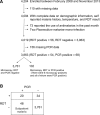Characteristics of Subpatent Malaria in a Pre-Elimination Setting in Southern Zambia
- PMID: 30526744
- PMCID: PMC6367603
- DOI: 10.4269/ajtmh.18-0399
Characteristics of Subpatent Malaria in a Pre-Elimination Setting in Southern Zambia
Abstract
To achieve and sustain malaria elimination, identification and treatment of the asymptomatic infectious reservoir is critical. Malaria rapid diagnostic tests (RDTs) are frequently used to identify asymptomatic, Plasmodium-infected individuals through test-and-treat strategies, but their sensitivity is low when used in low transmission settings. Characteristics of individuals with subpatent (RDT-negative but polymerase chain reaction [PCR]-positive) Plasmodium parasitemia were evaluated in southern Zambia where malaria transmission has declined and efforts to achieve malaria elimination are underway. Simple random sampling based on satellite imagery was used to select households for participation in community-based, cross-sectional surveys between 2008 and 2013. Questionnaires were administered to collect information on age, gender, recent history of malaria symptoms, and recent antimalarial drug use. Blood samples were collected by finger prick for Plasmodium falciparum histidine-rich protein 2 RDT, blood smears for microscopy, and dried blood spots for molecular analysis to detect malaria parasites and their sexual stage. Of 3,863 participants with complete data, 102 (2.6%) were positive by microscopy, RDT, or PCR. Of these, 48 (47%) had subpatent parasitemia. Most individuals with subpatent parasitemia were asymptomatic (85%). Compared with individuals without parasitemia, individuals with subpatent parasitemia were significantly more likely to be aged 5-25 years. Approximately one quarter (27%) of those with subpatent parasitemia had detectable gametocytemia. These findings suggest that strategies based on active or reactive case detection can identify asymptomatic individuals positive by RDT, but more sensitive diagnostic tests or focal drug administration may be necessary to target individuals with subpatent parasitemia to achieve malaria elimination.
Figures



References
-
- WHO , 2015. World Malaria Report Available at: http://www.who.int/malaria/publications/world-malaria-report-2015/report.... Accessed November 13, 2018.
-
- WHO , 2016. World Malaria Report Available at: http://www.who.int/malaria/publications/world-malaria-report-2016/report.... Accessed November 13, 2018.
-
- Searle KM, Hamapumbu H, Lubinda J, Shields TM, Pinchoff J, Kobayashi T, Stevenson JC, Bridges DJ, Larsen DA, Thuma PE, Moss WJ; Southern Africa International Centers of Excellence for Malaria Research , 2016. Evaluation of the operational challenges in implementing reactive screen-and-treat and implications of reactive case detection strategies for malaria elimination in a region of low transmission in southern Zambia. Malar J 15: 412. - PMC - PubMed
-
- Lindblade KA, Steinhardt L, Samuels A, Kachur SP, Slutsker L, 2013. The silent threat: asymptomatic parasitemia and malaria transmission. Expert Rev Anti Infect Ther 11: 623–639. - PubMed
Publication types
MeSH terms
Substances
Grants and funding
LinkOut - more resources
Full Text Sources

